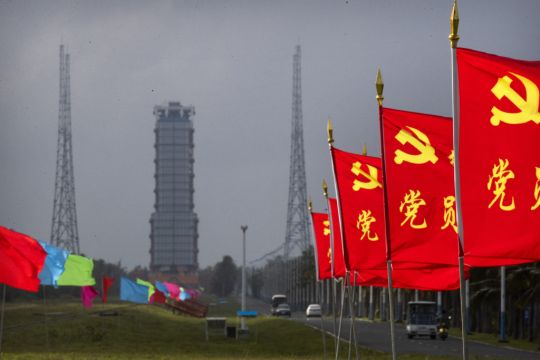Chinese technicians are making final preparations for a mission to bring back material from the moon’s surface in what would be a major advance for the country’s space programme.
Chang’e 5 is China’s most ambitious lunar mission yet. It marks the first time in four decades that any country has sought to bring rocks and debris from the moon to Earth.
This could boost human understanding of the moon, its age and resources, and of the solar system more generally.

The four modules of the Chang’e 5 spacecraft are expected be sent into space on Tuesday. They will be sent aboard a massive Long March-5 rocket from the Wenchang Space Launch Site on the southern island province of Hainan, according to a NASA description of the mission.
The secretive China National Space Administration (CNSA) has only said that a launch is scheduled for late November.
The mission’s key task is to drill two metres (almost seven feet) beneath the moon’s surface and scoop up about two kilograms of rocks and other debris to be brought back to Earth.
It would the first opportunity scientists have had to study newly obtained lunar material since the American and Russian missions of the 1960s and 1970s.

Jonathan McDowell, an astronomer at the Harvard-Smithsonian Centre for Astrophysics, said that the mission is “indeed challenging”.
However, he stressed that China has already landed twice on the moon with its Chang’e 3 and Chang’e 4 missions. A 2014 Chang’e 5 test mission also showed that it can navigate back to Earth, re-enter and land a capsule.
All that’s left is to show Chang’e 5 can collect samples and take off again from the moon, Dr McDowell said.
“As a result of this, I’m pretty optimistic that China can pull this off,” he said.
Such experience is growing in value with more countries conducting asteroid sample returns and considering Mars sample returns, Dr McDowell said.

After making the three-day trip from Earth, the Chang’e 5 lander’s time on the moon is scheduled to be short and sweet. It can only stay one lunar daytime – about 14 days – because it lacks the radioisotope heating units that China’s current lunar rover, the Chang’e 4, possesses to withstand the moon’s freezing nights.
Launched as a single space craft, Chang’e 5 is actually composed of a lander, ascender, service module and return capsule.
The lander will dig for materials with its drill and robotic arm and transfer them to the ascender, which will lift off from the moon and dock with the service capsule. The materials will then be moved to the return capsule for the trip home to earth.
Joan Johnson-Freese, a space expert at the US Naval War College, said that the technical complexity of Chang’e 5, with its four components, makes it “remarkable in many ways”.
If successful, it could be a blueprint for a Mars sample return or even a crewed lunar mission.
She added: “China is showing itself capable of developing and successfully carrying out sustained high-tech programmes, important for regional influence and potentially global partnerships.”

The mission, named after the Chinese moon goddess Chang’e, is among China’s boldest since it first put a man in space in 2003, becoming only the third nation to do so after the US and Russia.
While many of China’s crewed spaceflight achievements, including building an experimental space station and conducting a space walk, reproduce those of other countries from years past, the CNSA is now moving into new territory.
Chang’e 4 —the first soft landing on the moon’s relatively unexplored far side — is providing full measurements of radiation exposure from the lunar surface, information vital for any country that plans to send astronauts to the moon.
China in July became one of three countries to have launched a mission to Mars – in China’s case an orbiter and a rover that will search for signs of water on the red planet. The CNSA says the spacecraft Tianwen 1 is on course to arrive at Mars around February.
China has increasingly engaged with foreign countries on missions and the European Space Agency will be providing important ground station information for Chang’e 5.

US law however still prevents most collaborations with NASA, excluding China from partnering with the International Space Station. That has prompted China to start work on its own space station and launch its own programmes that have put it in competition with Asian countries such as Japan and India which are seeking to notch new achievements in space.
China’s space programme has progressed cautiously, with relatively few setbacks in recent years. The Long March-5 rocket, nicknamed “Fat 5” because of its bulky shape, failed on a previous launch attempt, but has since performed without a glitch, including launching Chang’e 4.
Prof Johnson-Freese said: “China works very incrementally, developing building blocks for long-term use for a variety of missions.”
She added that China’s one-party authoritarian system also allows for “prolonged political will that is often difficult in democracies”.
But experts have warned that while the US has followed China’s successes closely, it is unlikely to engage China in space amid political suspicions, a sharpening military rivalry and accusations of Chinese theft of technology.
Prof Johnson-Freese said: “A change in US policy regarding space cooperation is unlikely to get much government attention in the near future.”







